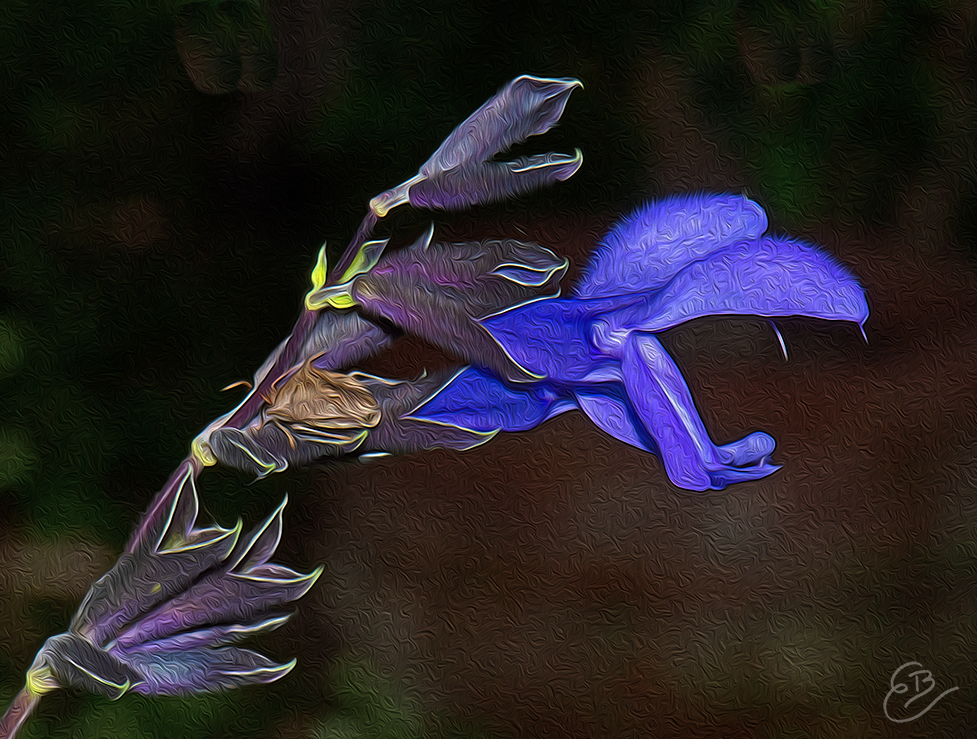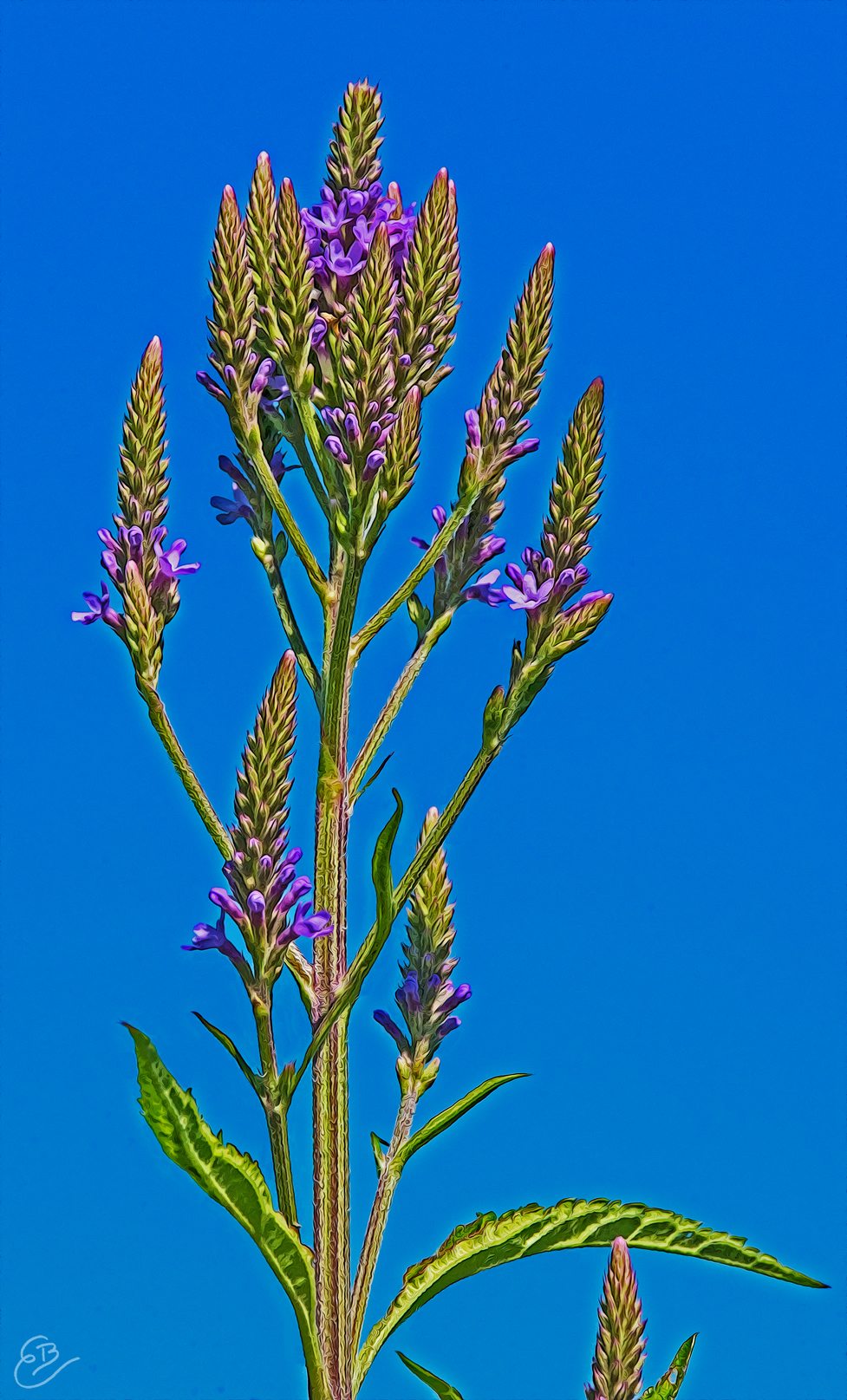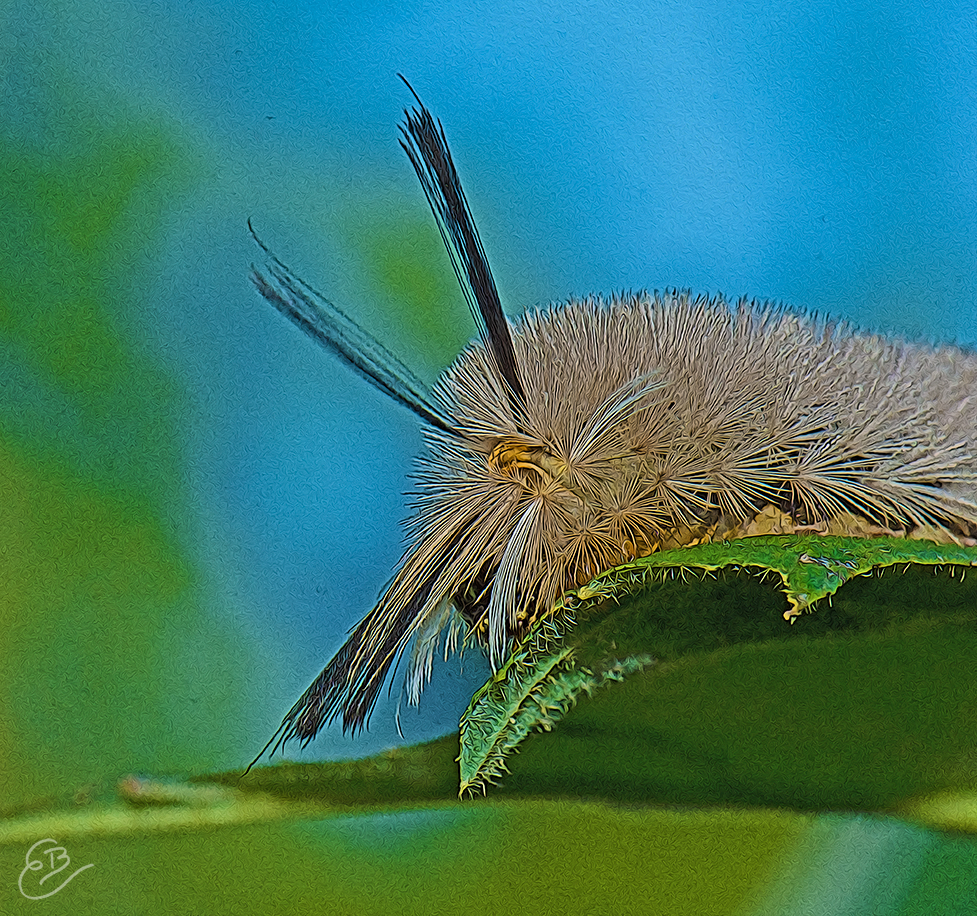
The Dragon's Mouth
The captivating blossoms of the Black and Blue Sage cast the image of a dragon's mouth onto our imagination. A tall and friendly perennial, Salvia guaranitica is one of our favorite summertime flowering plants — a fine representative of the ‘Genus of Sage’. Butterflies and hummingbirds treat it like a delicacy. This cultivar was likely carved out of the better-known Salvia officinalis — either through natural selection in South America, or by some ambitious botanist with a flair for the poetic. Native to Brazil, Paraguay, Uruguay, and Argentina, the Black and Blue is prized for its aroma — the Mistress of the Hacienda swears it smells like anise. To the untrained nose, it just smells good … and presents a pretty shade of dark blue amidst the yellows, reds, pinks, and oranges of summertime's flowers. PS: Black and Blue's well-known cousin, Salvia officinalis, an ancient herb, is dried, crushed, and put into little bottles for the chef's spice rack. Another cousin, Salvia divinorum, is famous as the Sage of the Diviners … the seer's sage. Its leaves are chewed, smoked, or made into a tea to activate transient psychoactive hallucinations, similar, we are told, to the buzz delivered by opium.
3 Dog Acres | rural Washington County, Arkansas
Image by Ebenezer | 25 July 2019

Time to Go Native
Let's Hear It for the Wild Ones
By Ebenezer Baldwin Bowles
10 June 2020
Ever active and always altruistic, Eric Fuselier has organized a new chapter of the Wild Ones, a national volunteer organization devoted to native plants and natural landscapes. Not one to sit and wait for something to happen, Mr. Fuselier is charging ahead with the Ozark Chapter's first major collaborative project, a rain garden and native plant garden at the Lake Springdale trailhead.
Jonathan Perrodin of the Northwest Arkansas Master Naturalists serves as overall project manager. It's likely that many of the plants will be provided by the Master Naturalists native plants greenhouse. Springdale Parks and Recreation is also involved in this very special project.
The start date for digging and planting is currently in a wait-and-see status because of the Corona virus pandemic. “We had generated lots of positive momentum before the pandemic hit,” Eric said. “The goal now is to make sure we don't lose any of the interest our members demonstrated in the spring, so we're seeing what we can do virtually until we can get back out into the field.”
Eric collaborated with Wild Ones members Lissa Morrison and Scott Biehle on the native plant landscaping design for the Springdale project. The design includes the following plants: buttonbush, hydrangea, possumhaw, winterberry, ninebark, aromatic sumac, Arkansas bluestar, swamp milkweed, plains oval sedge, inland sea oats, purple coneflower, rose verbena, St. Andrew's cross, St John's wort, common rush, cardinal flower, blue lobelia, pink muhly, orange coneflower, and aromatic aster.
The Advantages of Low Impact Development
Meanwhile, Eric — one of the natural world's most ardent friends — is preparing for a virtual workshop on Saturday, June 13, to highlight the advantages of low impact development (LID). Eric and his Wild Ones cohorts are partnering with the OMNI Center for Peace, Justice, and Ecology of Fayetteville to carry forward the message of healthy water. Jane Maginot, Water Quality Agent for Washington County, and Lee Porter of Ozark Green Roofs will also participate in the program.
Among items on the agenda are various methods and techniques to slow down, spread out, and soak in stormwater on-site by creating a more environmentally friendly place for wildlife while improving soil and protecting water quality. Additional topics will include green roofs, rain gardens, and phytoremediation.
The two-hour virtual workshop via Zoom begins at 3 p.m. To receive the Zoom link for this talk, please register by sending an email to Jane at jmaginot@uaex.edu. If you can't make the June 13th live event, please register and a recording will be made available at a later date.


The Quest for Biodiversity
Among the most popular expressions of the quest for biodiversity on the planet today, the native plant movement attracts a high level of attention from conservationists, ecologists, and citizen scientists. We call it a movement because it is one — a series of actions and events designed to inspire adherents to work collectively for the common good through the planting and care of native plants.
One unique approach to advancing the movement is currently underway at the Beaver Watershed Alliance, which recently announced a new project, the High Tunnel Pilot Program, to inspire landowners within the watershed to go native by establishing a high tunnel system on their property. In case you've never heard the term high tunnel — we hadn't — it refers to a solar greenhouse covered in polyethylene and designed to allow homeowners to grow native plants in starter containers and also to extend the length of the growing season.
The Alliance will provide landowners who are approved for the pilot program with expert assistance in purchasing and installing the high tunnel system. Participants will also receive a starter kit of seeds and containers to jump start the growing process.
A Grant to Reward Innovation
The program, according to Alliance literature, is funded in partnership with the Natural Resources Conservation Service through the Conservation Innovation Grant program. Interested landowners should contact program coordinator Nate Weston at the Alliance: 479-750-8007. The grant can fund up to twenty private landowners and land managers with grants up to $4,000. To read a fact sheet about the program, kindly click the Beaver Watershed Alliance logo up above.

Blue Vervain
An ancient plant of mysterious power, the Common Vervain — Verbena officinalis — with the help of a conjuror can cast spells on enemies or coax enchantments out of Mother Earth. That's saying something! Egyptians in the time of the pharaohs called Vervain the “Tears of Isis” — the goddess cried upon learning of the death of Osiris, and when her tears fell to Mother Earth, up sprang the Vervain. Christians of long ago believed the ‘Holy Herb Vervain’ was used to staunch the wounds of Jesus when he was taken down from the cross. “Vervain was employed by the ancients in various kinds of divinations,” writes Frederic Shoberl, editor of the 1848 edition of The Language of Flowers. “They ascribed to it a thousand properties, and among others that of reconciling enemies. Whenever the Romans sent their herald to offer peace or war to nations, one of them always carried a sprig of Vervain. The Druids, both in Gaul and Britain, regarded the Vervain with the same veneration as the mistletoe, and offered sacrifices to the earth before they cut this plant in spring, which was a ceremony of great pomp.” BTW, don't fret (too much) if you think someone's gonna cast a spell on you with their Tears of Isis plant. Find you a Vervain and cast your own spell of protection. This powerful plant works both ways. It's magic.
Woolsey Wet Prairie | Fayetteville, Arkansas
Image by Ebenezer | 12 July 2019

Life Attracts Life
in the Burren of Ireland
A fifteen-year project to radically reshape farming in the Burren limestone region (County Clare) of Ireland is yielding positive results. More than 300 cattle ranchers have repurposed their austere, hilly land to support “greening measures” and ecological-based farming systems, leading to decreased ground water pollution and enhanced biodiversity, according to a report in The Guardian of 6 June. Farmers are paid an annual subsidy averaging six-thousand pounds to raise “resilient breeds” of cattle toward the goal of creating “nature-filled fields and clean waterways.” The project “has rejuvenated an ancient tradition called ‘winterage,’ where cattle spend the cold months on the uplands,” The Guardian reports. “They graze down the tough, hardy grasses which provide space for rare flowers in spring; here the limestone slabs act as giant hot-water bottles, slowly dissipating the summer heat stored in the rocks. It has transformed parts of the uplands into species-rich calcareous grasslands, replete with native flowers such as O'Kelly's spotted orchid, the perennial mountain-avens and the rare lesser twayblade orchid. Life attracts life; each summer, butterflies such as the pearl-bordered fritillary and the brown hairstreak can be seen in the fields, and it's now not uncommon to hear the distinctive soprano buzz of the shrill carder bee.”



Bachelor's Button and Trees in Winter
The blue cornflower, aka Bachelor's Button, scientific name Centaurea cyanus, caught our eye last summer while walking along the paths at Woolsey Wet Prairie. He stood tall and alone alongside one of the back paths, his blue swirling shape easy to spot amongst the greens and creamy browns of the wet prairie landscape. Botanists tell us the Bachelor's Button usually presents as a collective of many delicate blue blossoms, so our specimen was special as an anomaly. The plant self-sows with vigor, making itself the target of nativists and farmers. The USDA lists the Blue Cornflower as “introduced, invasive, and noxious.” Here at the Cottage, we invite its invasion — beauty for beauty's sake. As for the tree, it's either an oak or a walnut. We chose it today for its stark form and striking presence on the landscape. “A tree in winter is far from being the characterless object many believe,” Dr. Blakeslee and Dr. Jarvis write in their 1913 textbook, Trees in Winter. “The majority view trees as elements in the world of beauty out of doors. The highest expression of an appreciation of this beauty appears in the form of poetry or art.”
Woolsey Wet Prairie | Fayetteville, Arkansas
Image by Ebenezer | 16 August 2019

Native Wild Rice Dilemma
A sharp decline in wild rice production in shallow lakes and rivers within the Ojibwe's Lac du Flambeau Reservation in north Wisconsin may eventually threaten traditional ceremonies based on the harvest from family rice farms. Rice yields of about 200 pounds per family in the 1920s now top out at 80 pounds on a good year. Causes for the native wild rice dilemma are debatable, though many point to global warming and climate change issues. Logging, river channeling, water temperature, excessive summer heat, extreme precipitation, and alteration of water chemistry due to erosion collectively contribute to the low yields. Source: Nature World News.

Wild Whiskers Caterpillar
The only place we've seen this critter go by the name Wild Whiskers Caterpillar is on the Bug Guide dot net, an amazing website hosted by Iowa State University’s Department of Entomology. For sure Wild Whiskers is an appro cognomen for our hairy friend. The scientific name, Halysidota tessellaris, covers all four stages of the moth's lifecycle, eventually taking us to the far side of metamorphosis, where we find the adult moth, a real beauty who goes by the name Banded Tussock moth, aka the Pale Tiger moth. There's a gorgeous image of her on the other side of this link: Banded Tussock moth. We also invite you to YouTube for a motion picture of Wild Whiskers in action.
3 Dog Acres | rural Washington County, Arkansas
Image by Ebenezer | 25 July 2019


“A Natural Promise: Embracing Hope” is the Crow's Cottage feature about the Arkansas Native Seed Program. Inspired by the Beaver Watershed Alliance's Quarterly Speaker Series at the West Fork Library in February 2019, the essay calls on environmental leaders Jennifer Ogle, Clell Ford, Dave Leisure, and Jonathan Young to tell the story of a very important initiative of conservation and preservation.
As always, we invite you to write us letter of encouragement or correction. You can even chastise us if you're respectful. Expect a courteous and timely reply. And let us know if you'd like to receive a notice about new features. Our address is ebenezer@crowscottage.com





